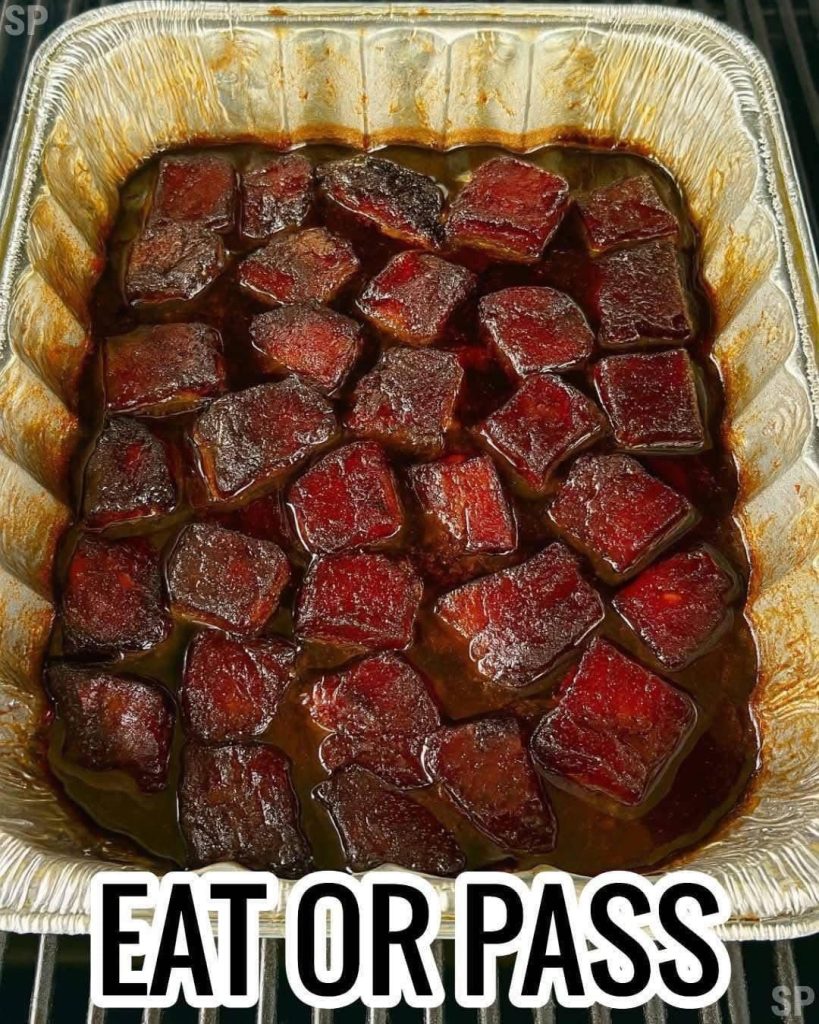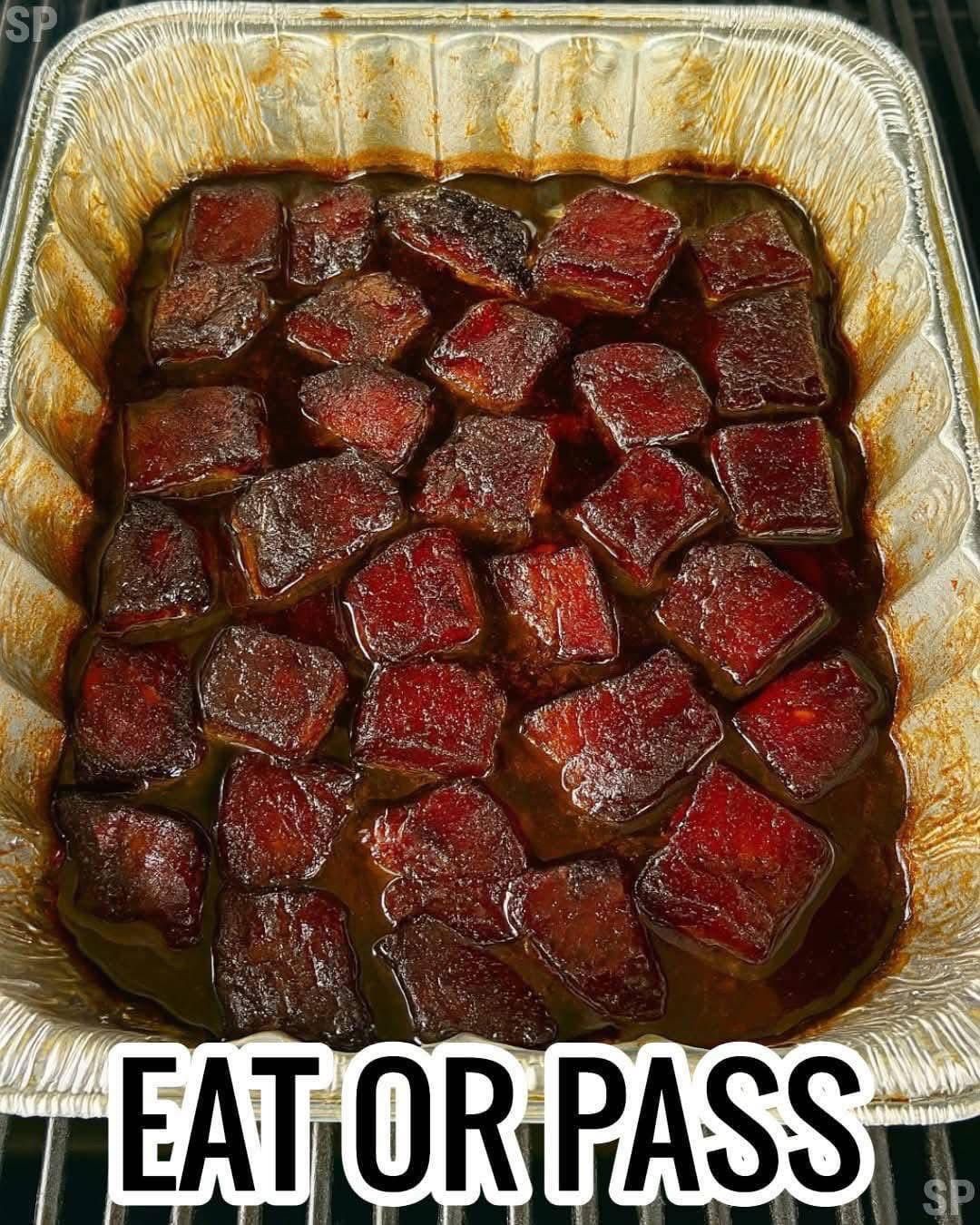Introduction
Burnt ends are a famous barbecue delicacy, originally made from the point end of a smoked beef brisket. Known for their crispy exterior, tender inside, and deeply smoky flavor, burnt ends have evolved into a variety of creative dishes. One such modern take is Hot Honey Burnt Ends, where spicy-sweet glaze meets smoky barbecue in a rich, sticky combination.
Hot honey burnt ends offer the perfect balance of textures and flavors. The sweetness from honey is balanced by the kick of chili, making this dish a favorite for those who enjoy bold and dynamic tastes. This version works wonderfully with beef brisket, chuck roast, or even pork belly.
In this article, we will explore:
- The complete hot honey burnt ends recipe
- Variations of meat and techniques
- The role of hot honey in flavor development
- Step-by-step cooking instructions
- Storage, serving, and customization tips
- Nutritional and preparation notes
Ingredients
For the Meat
- 4 to 5 pounds beef brisket point, chuck roast, or pork belly
- 2 tablespoons olive oil or yellow mustard (binder)
For the Dry Rub
- 1 tablespoon brown sugar
- 1 tablespoon smoked paprika
- 1 teaspoon garlic powder
- 1 teaspoon onion powder
- 1 teaspoon chili powder
- 1 teaspoon salt
- 1/2 teaspoon ground black pepper
- 1/2 teaspoon cayenne pepper (adjust to heat preference)
For the Hot Honey Sauce
- 1/2 cup honey
- 2 tablespoons hot sauce (like Frank’s RedHot or Sriracha)
- 1 tablespoon butter
- 1 tablespoon apple cider vinegar
- Optional: crushed red pepper flakes for extra heat
For Braising (Optional but Recommended)
- 1/4 cup barbecue sauce
- 2 tablespoons brown sugar
- 2 tablespoons butter
- Splash of apple juice or broth (for moisture)
Equipment Needed
- Smoker or oven
- Foil trays or roasting pan
- Meat thermometer
- Aluminum foil
- Sharp knife and cutting board
- Small saucepan

Step-by-Step Cooking Instructions
Step 1: Prepare the Meat
- Trim excess fat from the brisket or chuck roast, leaving some fat for moisture.
- Cut the meat into 1.5 to 2 inch cubes.
- Coat each cube lightly with olive oil or mustard to help the seasoning stick.
Step 2: Apply the Dry Rub
- Mix all dry rub ingredients in a bowl.
- Generously season each meat cube on all sides.
- Let the meat rest for 15 to 30 minutes at room temperature to absorb flavors.
Step 3: Smoking or Roasting the Meat
Smoking Option
- Preheat smoker to 250°F (120°C) using hickory, oak, or fruitwood.
- Place the meat cubes on a wire rack or directly on smoker grates.
- Smoke for about 2.5 to 3 hours, or until the internal temperature reaches around 165°F (74°C) and a crust begins to form.
Oven Option
- Preheat oven to 300°F (150°C).
- Place meat on a baking sheet with parchment or a roasting rack.
- Bake uncovered for 2.5 hours or until crust forms and internal temp is around 165°F.
Step 4: Braising
- Transfer meat cubes into a foil tray or pan.
- Add barbecue sauce, brown sugar, butter, and a splash of juice or broth.
- Cover tightly with foil.
- Return to smoker or oven for another 1.5 to 2 hours, until cubes are tender and internal temp is over 195°F (90°C).
Step 5: Hot Honey Glaze
- In a saucepan over medium heat, melt the butter.
- Add honey, hot sauce, and apple cider vinegar.
- Stir continuously for 2 to 3 minutes until it bubbles slightly and thickens.
- Optional: Add chili flakes for extra heat.
Step 6: Final Glaze and Caramelization
- Remove foil from the pan of burnt ends.
- Drizzle hot honey glaze over the meat and toss gently to coat.
- Place uncovered back in the smoker or oven for 15 to 20 minutes.
- Let the glaze thicken and caramelize. Watch closely to avoid burning.
Step 7: Serve
- Remove from heat and let rest for a few minutes.
- Serve hot as an appetizer or main course with sides like mac and cheese, coleslaw, or cornbread.
What Makes Hot Honey Special
Hot honey is a simple combination of honey and heat, typically achieved by mixing honey with hot sauce or infused chili. It enhances food by balancing sweetness with spice and is increasingly used in barbecue dishes.
The sugar in honey caramelizes under heat, helping to develop a sticky glaze with rich flavor. The added spice from hot sauce or chili flakes cuts through the sweetness, resulting in a layered taste experience. This makes hot honey an excellent pairing with smoked meats, especially burnt ends, which already have a deep umami profile.
Meat Selection and Alternatives
While brisket point is traditional for burnt ends, it is not the only choice. The cooking method and glaze can be applied to several types of meat:
1. Chuck Roast
Affordable and well-marbled, chuck roast mimics brisket texture when cooked low and slow.
2. Pork Belly
Richer and fattier, pork belly burnt ends are softer and often cook faster. Great for those who prefer tender bites with intense flavor.
3. Chicken Thighs
For a leaner alternative, boneless skinless chicken thighs work well. Adjust cook times accordingly, as chicken requires a shorter cooking period and reaches safe temperature at 165°F (74°C).
Flavor Variations and Customization
The hot honey base can be customized in many ways:
1. Garlic Honey
Add fresh minced garlic or garlic powder to the sauce for a more savory bite.
2. Smoky Honey
Use chipotle hot sauce or smoked paprika for added smokiness in the glaze.
3. Sweet and Tangy
Add a splash of lemon juice or Dijon mustard to brighten the sweetness.
4. Extra Spicy
Use habanero hot sauce or include chopped chili peppers in the glaze.
Storage and Reheating
Refrigeration
Place cooled burnt ends in an airtight container. Store in the refrigerator for up to 4 days.
Freezing
Wrap tightly in foil and place in a freezer-safe container. Store for up to 2 months. Thaw overnight in the fridge before reheating.
Reheating
Warm in a covered dish in the oven at 325°F (160°C) for 10 to 15 minutes, or microwave in short intervals while keeping the meat moist with a spoonful of sauce.
Serving Suggestions
Hot honey burnt ends are highly versatile. Here are ways to serve them:
- On a toasted brioche bun as a sandwich
- Over creamy mashed potatoes or rice
- Alongside grilled vegetables or salad
- With macaroni and cheese or cornbread
- As part of a barbecue platter
Their sweet and spicy nature complements creamy, tangy, or starchy side dishes beautifully.
Nutritional Considerations
While delicious, burnt ends are indulgent. A typical serving of hot honey burnt ends can contain:
- Calories: 400 to 600 kcal per serving
- Protein: 25 to 30 grams
- Fat: 30 to 40 grams (depending on meat cut and butter)
- Sugar: 15 to 25 grams (due to honey and barbecue sauce)
Reducing butter or using leaner cuts like chicken can help reduce overall fat. Consider balancing the meal with lighter side dishes or salads.
Final Thoughts
Hot honey burnt ends are a flavor-packed dish that brings together the best of barbecue cooking with modern heat and sweetness. The dish represents how traditional smoked meats can be transformed with just a few ingredients like honey and hot sauce.
The contrast between smoky meat, crispy bark, and sticky hot honey glaze delivers a taste experience that is rich, bold, and satisfying. Whether made with brisket, pork belly, or beef roast, this dish is sure to impress guests or satisfy personal cravings.
The key lies in patience, temperature control, and balance in seasoning. Once mastered, hot honey burnt ends become a go-to recipe for barbecues, family dinners, and special gatherings.
This dish is more than just food; it is a statement of flavor and technique. With just a few steps and quality ingredients, you can create restaurant-quality burnt ends right in your own kitchen or backyard smoker.
